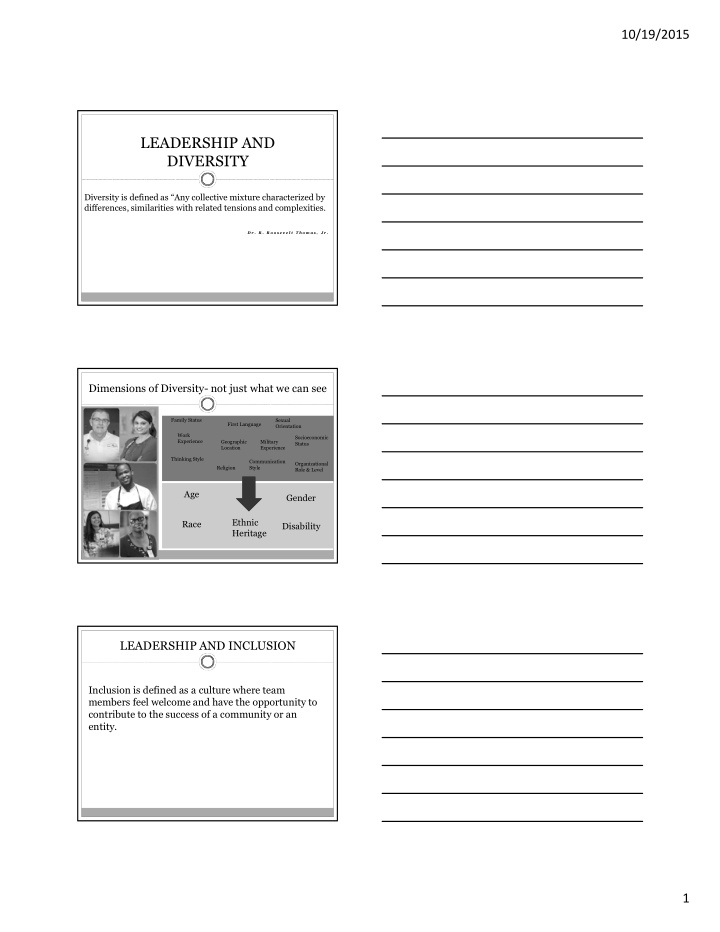



10/19/2015 LEADERSHIP AND DIVERSITY Diversity is defined as “Any collective mixture characterized by differences, similarities with related tensions and complexities. D r . R . R o o s e v e l t T h o m a s , J r . Dimensions of Diversity- not just what we can see Family Status Sexual First Language Orientation Work Socioeconomic Experience Geographic Military Status Location Experience Thinking Style Communication Organizational Religion Style Role & Level Age Gender Ethnic Race Disability Heritage LEADERSHIP AND INCLUSION Inclusion is defined as a culture where team members feel welcome and have the opportunity to contribute to the success of a community or an entity. 1
10/19/2015 Why is Diversity and Inclusion important? Approximately 75% baby boomers are retiring 1 in 5 people have a disability 40% of households are lead by women America is browning: in 2050 minorities will exceed 50% of the population LEADERSHIP AND CULTURAL COMPETENCE Cultural competence is defined as the ability to respond effectively and appropriately to different backgrounds, opinions and perceptions Ways Leaders display and increase CULTURAL COMPETENCE Respect Other’s Opinio ns Acknowledge Cultural/ Gener at ional Differ enc es And Historical Injustic es Without Becoming Defensiv e. Be Open To Learning About Other Cultures And Ideas. Give Others The Benefit Of The Doubt In A Disput e. Seek First To Understand Others’ Point Of Views; Then To Be Understoo d. Don’t Stereoty pe. Don’t Judge Others By Your Own Cultural Standar ds . Don’t Assume Your Culture’s Way Is The Only Way. Don’t Talk Down To Anyone; Communicat e Effectiv ely . 2
10/19/2015 CULTURAL INTELLIGENCE Cultural Intelligence is having the capacity and knowledge to work effectively with people from different cultural groups with or without having prior experience. PREJUDICE Prejudice is a preconceived opinion that is not based on reason or actual experience; formed beforehand. STEROTYPING To Stereotype is to believe, unfairly, that all people or things with a particular characteristic(s) are the same; a widely held but fixed and oversimplified image or idea of a particular type of person or thing. Do you stereotype at times? If you answer yes, that’s okay—we all do. 3
10/19/2015 BIAS Bias is showing favor to a person, group, or idea over another. Can you think of a work situation where you have been bias? Leaders must develop competencies for diversity and inclusion to be successful, this is no easy task. Relationship Building Addresses conflict appropriately Explains, persuades and encourages in desired direction Is trusted by others Is respectful and honest in all situations Strives for win/win Integrity and Ethics Communicates values and vision with passion and clarity Models ethical values and Standards of Behavior Helps others resolve ethical dilemmas Acts in a fair and ethical manner towards others Follows through on promises and commitments Continued People Developing: Assigns work based on a person’s potential Recruits and retains best people Teaches and coaches others in a helpful manner Shows genuine concern about the development of other’s careers Builds other’s self-esteem Team Building Clearly identifies goals for team members Explains each team member’s role Manages conflict effectively Leads by example Promotes a spirit of cooperation within teams Diversity Hires without regard to race, nationality, culture, disability or gender Supports equal and fair treatment and opportunity for all team members Understands and manages diversity 4
10/19/2015 Diversity Management “ The process of creating and maintaining an environment that naturally enables all team members to contribute their full potential in focused pursuit of the organization’s objectives. “ (Roosevelt Thomas Consulting and Training, Inc.) Leaders Should 1. Let inclusion begin with you. the “ leader. 2. Acknowledge that every one is not all the same. 3. Get to know your employees as individuals. “ 4. Recognize personal biases. Leaders Should 5. Optimize the differences and similarities employees bring to the “ workplace. 6. Have open and honest communication. 7. Resolve to be fair with all employees “ 8. Make a personal goal that you will make everyone you encounter feel respected, valued and visible. 5
10/19/2015 The Benefits of Diversity and Inclusion Add discussion on metrics Pipeline Development Talent Management Leadership Support Supplier Diversity “We could learn a lot from crayons: some are sharp, some are pretty, some are dull, while others are bright, some have weird names, but they have to learn to live in the same box." - Anonymou s ------- You might not choose all of your team mates if you were to have put together the team yourself, but that doesn't mean you don't have to work with them and try to get along. The workforce is a diverse place and the sooner you learn how to deal with diversity in a collaborative environment, the smoother the collaboration will work. True love of humanity conquers all Words to Consider Each individual brings his or her diversity to each situation at all times –AND “ “When we feel a sense of belonging it’s not because we are the same as everyone “ else, but because we have been accepted as we are.” 6
10/19/2015 EVERYONE WANTS TO FEEL VISIBLE, RESPECTED AND VALUED 7
Recommend
More recommend